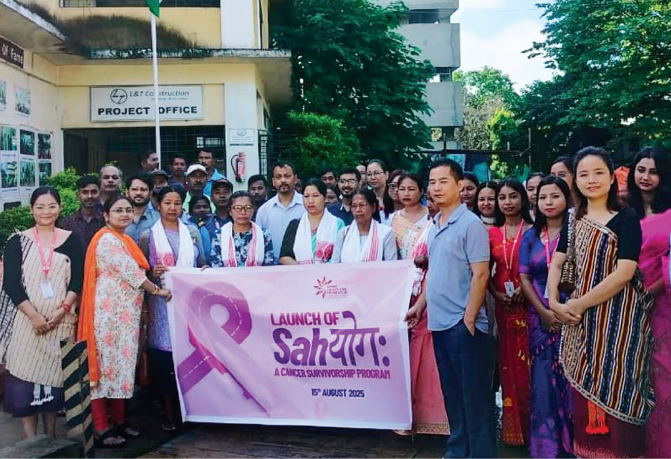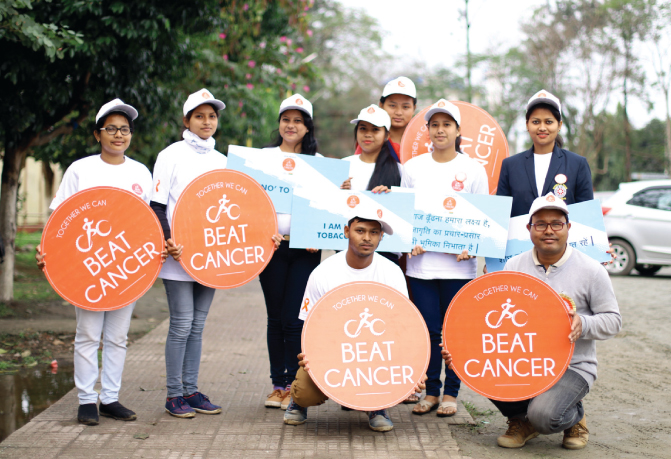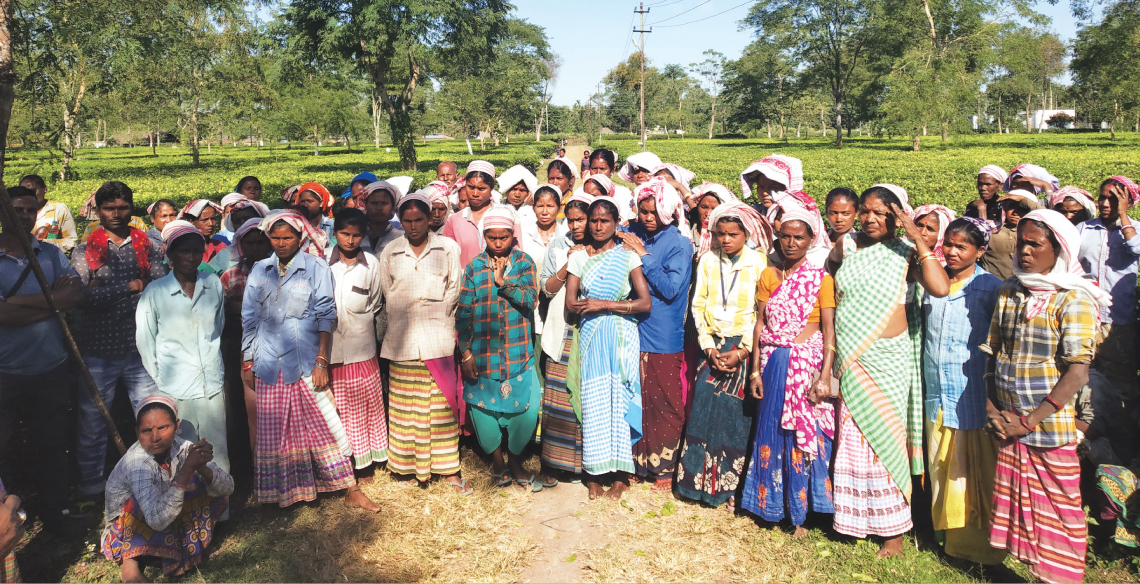The pyramid rises
Inventive and effective, the ‘distributed cancer care model’ rests on the pillars of accessibility, affordability, quality and community outreach
Sibu, a daily wager from Sivasagar in Assam, was going about his life when he discovered he had a tumour in his mouth. Initial tests at the nearby Assam Medical College and Hospital (AMCH) indicated a possibility of oral cancer and surgery. Having spent ₹15,000 on investigative radiology tests, a huge sum for him, Sibu realised he would need more money for further treatment.
It wasn’t just the money. The 50-year-old was unsure where to go for his procedure. The State Cancer Institute (SCI) in Guwahati, which has a reputation for providing good and affordable care, was his best bet. But that was 350km from Sivasagar, a journey that would take Sibu at least 10 hours by road. He would also have to find accommodation, adding to his expenses. A better bet for Sibu was the Dibrugarh Cancer Centre, just 80km away. He decided to continue his treatment there — and it saved his life.
The Dibrugarh Centre is part of the ‘distributed cancer care model’ (DCCM) promoted and supported by the Assam Cancer Care Foundation (ACCF), a nonprofit formed by the Tata Trusts in partnership with the Assam government in 2017. It comprises a multi-tiered system — like a pyramid — with the Guwahati SCI at the apex and a range of cancer care facilities under it to provide step-down services.
“The distributed cancer care model is based on two principles,” says Dr Rajendra A Badwe, former chief executive of the Tata Cancer Care Foundation and ex-director, Tata Memorial Centre (TMC) in Mumbai. “First, how common is the cancer and, second, what is the optimum number of patients required to be treated so that we can get the best results?”
High and low
For instance, gall bladder cancer is widely prevalent in West Bengal, Bihar, Odisha, Uttar Pradesh and the whole of the Northeast, where it collectively affects an estimated 20 of 100,000 people every year. But in Mumbai the incidence may be as low as 0.002 per 100,000. “That’s why there is less of a need to create infrastructure in western India for this type of cancer,” adds Dr Badwe. “The uniqueness of the problem and the number affected dictate the kind of systems and infrastructure required in a particular place.”
This includes population density. The incidence of all cancers in urban areas is 100-120 per 100,000 people per annum. In semi-urban areas this number drops to 60-75, and in rural India it is about 40-50. “There is the need, consequently, to distribute the facilities for cancer care slightly differently across India,” says Dr Badwe.
Till recently, cancer facilities were largely concentrated in the metros and tier-2 cities. Developed by the Tata Trusts to address this countrywide need, DCCM has four objectives: better and easier access to cancer facilities; affordable treatment; uniformly high-quality care; and awareness, early detection and palliative services.
The model has primarily been operationalised in Assam, a state lacking in cancer hospitals, with the larger goal of improving cancer care outcomes in all of Northeast India. The aim is to replicate DCCM in other states as well.
“Earlier, we had only two cancer hospitals in Assam, at Guwahati and Dibrugarh,” says Dr Jai Prakash Prasad, ACCF’s chief operating officer. “People would travel to other states for treatment, to the Tata Memorial Hospital in Mumbai, the Tata Medical Center in Kolkata and the like. Medical colleges in Assam did not even offer oncology as a subject, so there was no possibility of getting trained doctors and staff either.” DCCM has changed all that.
At the top of the DCCM structure is the level 1 hospital, equipped with a variety of oncology, laboratory and research facilities. In Assam, this position is occupied by SCI Guwahati. The next tier, level 2, has comprehensive cancer centres linked to government medical colleges, offering oncological and some allied services. These are at Dibrugarh, Silchar and Barpeta, with two more coming up at Diphu and Dhubri.
Four plus four
The ‘distributed cancer care model’ is built on four principles
- Enhanced access: Healthcare facilities within reach of communities, reducing the need for long-distance travel
- Uniform high-quality care: Ensure consistent, high-quality standards across all levels of care
- Affordable care: Make treatment affordable and accessible to a wider population
- Awareness, early detection and palliative care: Focus on educating the public, encouraging early symptom recognition, and providing palliative care
The ‘distributed cancer care model’ is built on four principles
- Level 1 (apex centres): State-of-the-art facilities providing comprehensive services, including radiation, surgery, medical oncology and advanced diagnostics
- Level 2: Dedicated cancer units within government medical colleges or multispecialty hospitals
- Level 3: District hospitals with diagnostic and daycare units, including chemotherapy services
- Level 4: Community-based outreach, including screening kiosks and mobile screening, and home-based palliative care
Diagnostics and daycare
At level 3 are diagnostic and daycare centres, providing radiotherapy and chemotherapy, that are annexed to district-level hospitals. Assam has five such centres, in the more far-flung areas of Kokrajhar, Lakhimpur, Jorhat, Darrang and Tezpur, with plans for six more (Goalpara, Nalbari, Nagaon, Sivasagar, Tinsukia and Golaghat).
Finally, at level 4 are the outreach and awareness programmes, including community screening via ‘Swasth Assam (health) kiosks’, and home-based palliative care. This level promotes early detection while also disseminating information in the community, via frontline workers, about medical and financial aid options for patients.
Door-to-door visits and follow-ups ensure that those from poor and underserved communities don’t abandon their treatment due to a lack of money or knowledge about the affordable and care-appropriate facilities within their reach. Timely intervention is also seen as crucial in halting the advance of cancers.
DCCM is driven by referrals, with lower-tier facilities — which offer limited services — pushing the more urgent cases up the ladder for the next level of intervention. This enables patients like Sibu to start their diagnostics and initial treatment at a facility closest to their homes, rather than visit faraway hospitals.
“About 60% of our patients are below the poverty line, and we don’t want them to travel for more than two to three hours to access the nearest cancer facility,” says Dr Prasad. “Otherwise, travel and accommodation costs alone can put them in financial distress. Our on-ground patient navigators organise vehicles or ambulances to ferry them back and forth. This is important to build confidence among people that a cancer centre nearby, offering the same level of facilities and care as a top hospital, is a preferable alternative.”
An important component of the model, one that minimises patient travel and ensures quality care, is Navya, a second-opinion portal. Patients fill out a detailed questionnaire, upload their test and biopsy reports and scans, and an AI tool generates an expert opinion from doctors attached to the National Cancer Grid, the pan-India network. Based on this, patients can understand if they are on the right treatment path, or if they have been prescribed a course that doesn’t quite fit with Indian (or global) protocols. “Navya makes excellent use of AI,” says Dr Badwe. “We have crossed more than 120,000 opinions already.”

The Navya advantage
The tool explores cancer guidelines in India and abroad and suggests an evidence-based, tailor-made treatment plan to doctors. “About 75% of the time, there is concurrence with the treating physician,” adds Dr Badwe. “In 25-30% of cases there may be some deviation, which can be corrected. We need a tool like Navya to provide uniform care across the country.”
If distributed cancer care were viewed as a hub-and-spoke model — with the level 1 hospital a hub and the step-down facilities as ‘spokes’ connected to this hub – India may require as many as 30-35 such systems. “That infrastructure will take 15-20 years to build,” says Dr Badwe.
Whether a facility is a hub or a spoke is decided by four factors: population, cancer incidence, type of cancer, and terrain. “Geographically, we need to understand where else in the Northeast we can set up hubs,” says Dr Prasad. “The whole region may require several hubs instead of just one at Guwahati. But the standard of care must be maintained throughout.”
The hub-and-spoke model offers differentiated (and therefore more accurate and efficient) management of cases. Hub hospitals, with their best-in-class facilities, specialised equipment and doctor-experts, can cater to both common and complex cases, leaving the ‘spokes’ to deal with the more treatable types. “The main idea is for patients to get a good percentage of treatment close to their home,” says Dr Badwe.
At an initial cost of ₹5-6 billion to set up, with a recurring annual cost of ₹1 billion, a hub hospital is an expensive proposition. Which is why it also needs to be financially sustainable. “We utilise the same infrastructure for people who can pay, and this helps us subsidise the treatment of those who cannot,” says Dr Badwe.

That’s where the question of trust comes in, says Dr Prasad. If better-off patients fund their own treatment, through insurance policies or otherwise, it can help the hospital minimise costs for those who really need help, achieve sustainability, and focus on improvement in innovation and care.
But a hospital seen as a facility only for the underprivileged will not attract well-off patients (who might gravitate to a private institution). “However, if we can show them that we offer a uniformly high level of care for all patients, rich or poor, it will bring the well-off people too. They have to trust that we will keep our promise, and that’s certainly one of the things we are working hard towards,” adds Dr Prasad.
